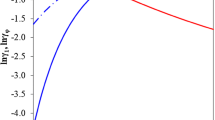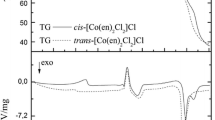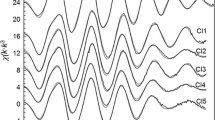Abstract
An aqueous thermodynamic model is proposed to describe the solubility ofTh(IV) hydrous oxide in the aqueous Na+-HCO -3 -CO 2-3 -OH--ClO -4 -H2O system extending to high concentration at 25‡C. This model is relatively simple in that only two aqueous species are included: Th(OH)3CO -3 and Th(CO3) 6-5 . Pitzer ion interaction parameters, Β(0) and Β(l) for Na+ with Th(CO3) 6-5 , are also determined (1.31 and 30, respectively). Reconciliation of all of the experimental solubility data for Th(IV) hydrous oxide in NaClO4 media required the introduction of a large mixing parameter for the highly charged Th(CO3) -4 . The relatively large values required for the ion interaction parameters Β(0) and Β(l), together with commensurately large mixing terms with the bulk anionic species, resulted in considerable uncertainty in determining standard state equilibrium constants for the formation of the highly charged Th(CO3) 6-5 species. This uncertainty is a result of the large contributions from Β(0) and Β(l) to the excess solution free energy at the concentrations (0.1m) where this species becomes important. The magnitude of the mixing term implies that formation of this species depends strongly upon the bulk ionic media. X-ray absorption results, confirming the presence of the thorium pentacarbonate species in concentrated bicarbonate and carbonate solutions, are also included.
Similar content being viewed by others
References
D. Rai, A. R. Felmy, D. A. Moore, and M. J. Mason,The Solubility of Th(IV) and U(IV) Hydrous Oxides in Concentrated NaHCO3 and Na2CO3 Solutions, Materials Research Society Symposium, Vol. 353, p. 1143 (1995).
D. L. Clark, S. D. Conradson, S. A. Ekberg, N. J. Hess, D. R. Janeky, M. P. Neu, P. D. Palmer, and C. D. Tait.New Journal of Chemistry 20, 211 (1996).
C. D. Tait, S. A. Eckberg, P. D. Palmer, and D. E. Morris,Plutonium Carbonate Specialion Changes as Measured in Dilute Solutions with Photoacoustic Spectroscopy, LA-12886-MS, (Los Alamos National Laboratory, Los Alamos, NM, 1995).
A. Joao, H. D. Burrows, L. Zikovsky, and M. Lipponen,Radiochim. Acta 68, 177 (1995).
E. Osthols, J. Bruno, and I. Grenthe,Geochimica et Cosmochim. Acta 58, 613 (1994).
K. S. Pitzer,J. Phys. Chem. 77, 268 (1973).
K. S. Pitzer,Ion Interaction Approach: Theory and Data Correlation Activity, Chap. 3 inCoefficients in Electrolyte Solutions, 2nd edn, K. S. Pitzer ed., CRC Press, Boca Raton, FL (1991).
A. R. Felmy and J. H. Weare,Geochim. Cosmochim. Acta 50, 2771 (1986).
A. R. Felmy, Dhanpat Rai, and R. W. Fulton,Am(III) Carbonato Complexes and Solubility Product of AmOHCO3(c) inPerformance Assessment Center for Engineered Barriers (PACE) Program, FY 1988 Summary Report PNC SA0865 89–001, (Power Reactor and Nuclear Fuels Development Corporation of Japan, 1989).
K. S. Pitzer,J. Solution Chem. 4, 249 (1975).
J. P. Greenberg, J. H. Weare, and C. E. Harvie,High Temp. Sci. 20, 1045 (1985).
C. E. Harvie, Ph.D. Dissertation #AAD82-03026, (University Microfilms, Ann Arbor, MI, 1987).
A. R. Felmy,GMIN, A Computerized Chemical Equilibrium Program Using a Constrained Minimization of the Gibbs Free Energy: Summary Report, Chap. 18 inChemical Equilibrium and Reaction Models, (Soil Science Society of America Special Publication 42, 1995).
C. E. Harvie, J. P. Greenberg, and J. H. Weare,Geochim. et Cosmochim. Acta 51, 1045 (1987).
C. E. Harvie,Theoretical Investigations in Geochemistry and Atom Surface Scattering, Ph.D. Dissertation, University of California, San Diego, CA, 1981.
A. R. Felmy, D. Rai, and M. J. Mason,Radiochim. Acta 55, 177 (1991).
D. Rai, J. L. Swanson, and J. L. Ryan,Radiochim. Acta 42, 35 (1987).
J. Grenthe,Chemical Thermodynamics of Uranium (NEA-OECD), (North-Holland Elsevier Sci. Publ., 19??)
C. E. Harvie, N. Moller, and J. H. Weare,Geochim. Cosmochim. Acta 48, 723 (1984).
P. S. Voliotis and A. Rimsky,Acta Cryst. B31, 2612 (1975).
S. I. Zabinsky, J. J. Rehr, A. Ankudinov, R. C. Albers, and M. J. Eller,Phys. Rev. B. 52, 2995 (1995).
J. J. Rehr, S. I. Zabinsky, and R. C. Albers,Phys. Rev. Let. 69, 3397 (1992).
Author information
Authors and Affiliations
Rights and permissions
About this article
Cite this article
Felmy, A.R., Rai, D., Sterner, S.M. et al. Thermodynamic models for highly charged aqueous species: Solubility of Th(IV) hydrous oxide in concentrated NaHCO3 and Na2CO3 solutions. J Solution Chem 26, 233–248 (1997). https://doi.org/10.1007/BF02767996
Received:
Revised:
Issue Date:
DOI: https://doi.org/10.1007/BF02767996




